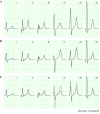Cardiac anisotropy in boundary-element models for the electrocardiogram
- PMID: 19306030
- PMCID: PMC2688616
- DOI: 10.1007/s11517-009-0472-x
Cardiac anisotropy in boundary-element models for the electrocardiogram
Abstract
The boundary-element method (BEM) is widely used for electrocardiogram (ECG) simulation. Its major disadvantage is its perceived inability to deal with the anisotropic electric conductivity of the myocardial interstitium, which led researchers to represent only intracellular anisotropy or neglect anisotropy altogether. We computed ECGs with a BEM model based on dipole sources that accounted for a "compound" anisotropy ratio. The ECGs were compared with those computed by a finite-difference model, in which intracellular and interstitial anisotropy could be represented without compromise. For a given set of conductivities, we always found a compound anisotropy value that led to acceptable differences between BEM and finite-difference results. In contrast, a fully isotropic model produced unacceptably large differences. A model that accounted only for intracellular anisotropy showed intermediate performance. We conclude that using a compound anisotropy ratio allows BEM-based ECG models to more accurately represent both anisotropies.
Figures


Similar articles
-
Comparative simulation of excitation and body surface electrocardiogram with isotropic and anisotropic computer heart models.IEEE Trans Biomed Eng. 1995 Apr;42(4):343-57. doi: 10.1109/10.376128. IEEE Trans Biomed Eng. 1995. PMID: 7729834
-
A bidomain model based BEM-FEM coupling formulation for anisotropic cardiac tissue.Ann Biomed Eng. 2000;28(10):1229-43. doi: 10.1114/1.1318927. Ann Biomed Eng. 2000. PMID: 11144984
-
Assessment of the equivalent dipole layer source model in the reconstruction of cardiac activation times on the basis of BSPMs produced by an anisotropic model of the heart.Med Biol Eng Comput. 2018 Jun;56(6):1013-1025. doi: 10.1007/s11517-017-1715-x. Epub 2017 Nov 13. Med Biol Eng Comput. 2018. PMID: 29130137 Free PMC article.
-
Models of the electrical activity of the heart and computer simulation of the electrocardiogram.Crit Rev Biomed Eng. 1988;16(1):1-66. Crit Rev Biomed Eng. 1988. PMID: 3293913 Review.
-
High-resolution electrocardiography.Crit Rev Biomed Eng. 1988;16(1):67-103. Crit Rev Biomed Eng. 1988. PMID: 3293914 Review.
Cited by
-
Effects of torso mesh density and electrode distribution on the accuracy of electrocardiographic imaging during atrial fibrillation.Front Physiol. 2022 Aug 29;13:908364. doi: 10.3389/fphys.2022.908364. eCollection 2022. Front Physiol. 2022. PMID: 36105286 Free PMC article.
-
Electrically conductive chitosan/carbon scaffolds for cardiac tissue engineering.Biomacromolecules. 2014 Feb 10;15(2):635-43. doi: 10.1021/bm401679q. Epub 2014 Jan 28. Biomacromolecules. 2014. PMID: 24417502 Free PMC article.
-
Computational assessment of drug-induced effects on the electrocardiogram: from ion channel to body surface potentials.Br J Pharmacol. 2013 Feb;168(3):718-33. doi: 10.1111/j.1476-5381.2012.02200.x. Br J Pharmacol. 2013. PMID: 22946617 Free PMC article.
-
Genetic algorithm-based regularization parameter estimation for the inverse electrocardiography problem using multiple constraints.Med Biol Eng Comput. 2013 Apr;51(4):367-75. doi: 10.1007/s11517-012-1005-6. Epub 2012 Dec 8. Med Biol Eng Comput. 2013. PMID: 23224834
-
Evaluation of a Rapid Anisotropic Model for ECG Simulation.Front Physiol. 2017 May 2;8:265. doi: 10.3389/fphys.2017.00265. eCollection 2017. Front Physiol. 2017. PMID: 28512434 Free PMC article.
References
-
- {'text': '', 'ref_index': 1, 'ids': [{'type': 'DOI', 'value': '10.1109/TBME.1987.326079', 'is_inner': False, 'url': 'https://doi.org/10.1109/tbme.1987.326079'}, {'type': 'PubMed', 'value': '3610193', 'is_inner': True, 'url': 'https://pubmed.ncbi.nlm.nih.gov/3610193/'}]}
- Aoki M, Okamoto Y, Musha T, Harumi KI (1987) Three-dimensional simulation of the ventricular depolarization and repolarization processes and body surface potentials: normal heart and bundle branch block. IEEE Trans Biomed Eng 34(6):454–462 - PubMed
-
- {'text': '', 'ref_index': 1, 'ids': [{'type': 'DOI', 'value': '10.1016/S0006-3495(67)86598-6', 'is_inner': False, 'url': 'https://doi.org/10.1016/s0006-3495(67)86598-6'}, {'type': 'PMC', 'value': 'PMC1368073', 'is_inner': False, 'url': 'https://pmc.ncbi.nlm.nih.gov/articles/PMC1368073/'}, {'type': 'PubMed', 'value': '6048873', 'is_inner': True, 'url': 'https://pubmed.ncbi.nlm.nih.gov/6048873/'}]}
- Barnard AC, Duck IM, Lynn MS (1967) The application of electromagnetic theory to electrocardiology; I. Derivation of the integral equations. Biophys J 7:443–462 - PMC - PubMed
-
- {'text': '', 'ref_index': 1, 'ids': [{'type': 'DOI', 'value': '10.1016/S0006-3495(67)86599-8', 'is_inner': False, 'url': 'https://doi.org/10.1016/s0006-3495(67)86599-8'}, {'type': 'PMC', 'value': 'PMC1368074', 'is_inner': False, 'url': 'https://pmc.ncbi.nlm.nih.gov/articles/PMC1368074/'}, {'type': 'PubMed', 'value': '6058137', 'is_inner': True, 'url': 'https://pubmed.ncbi.nlm.nih.gov/6058137/'}]}
- Barnard AC, Duck IM, Lynn MS, Timlake WP (1967) The application of electromagnetic theory to electrocardiology; II. Numerical solution of the integral equations. Biophys J 7:463–490 - PMC - PubMed
-
- {'text': '', 'ref_index': 1, 'ids': [{'type': 'DOI', 'value': '10.1109/TBME.1966.4502411', 'is_inner': False, 'url': 'https://doi.org/10.1109/tbme.1966.4502411'}, {'type': 'PubMed', 'value': '5964789', 'is_inner': True, 'url': 'https://pubmed.ncbi.nlm.nih.gov/5964789/'}]}
- Barr RC, Pilkington TC, Boineau JP, Spach MS (1966) Determining surface potentials from current dipoles, with application to electrocardiography. IEEE Trans Biomed Eng 13(2):88–92 - PubMed
-
- {'text': '', 'ref_index': 1, 'ids': [{'type': 'DOI', 'value': '10.1114/1.1527045', 'is_inner': False, 'url': 'https://doi.org/10.1114/1.1527045'}, {'type': 'PubMed', 'value': '12540206', 'is_inner': True, 'url': 'https://pubmed.ncbi.nlm.nih.gov/12540206/'}]}
- Buist M, Pullan A (2002) Torso coupling techniques for the forward problem of electrophysiology. Ann Biomed Eng 30:1299–1312 - PubMed
MeSH terms
LinkOut - more resources
Full Text Sources

